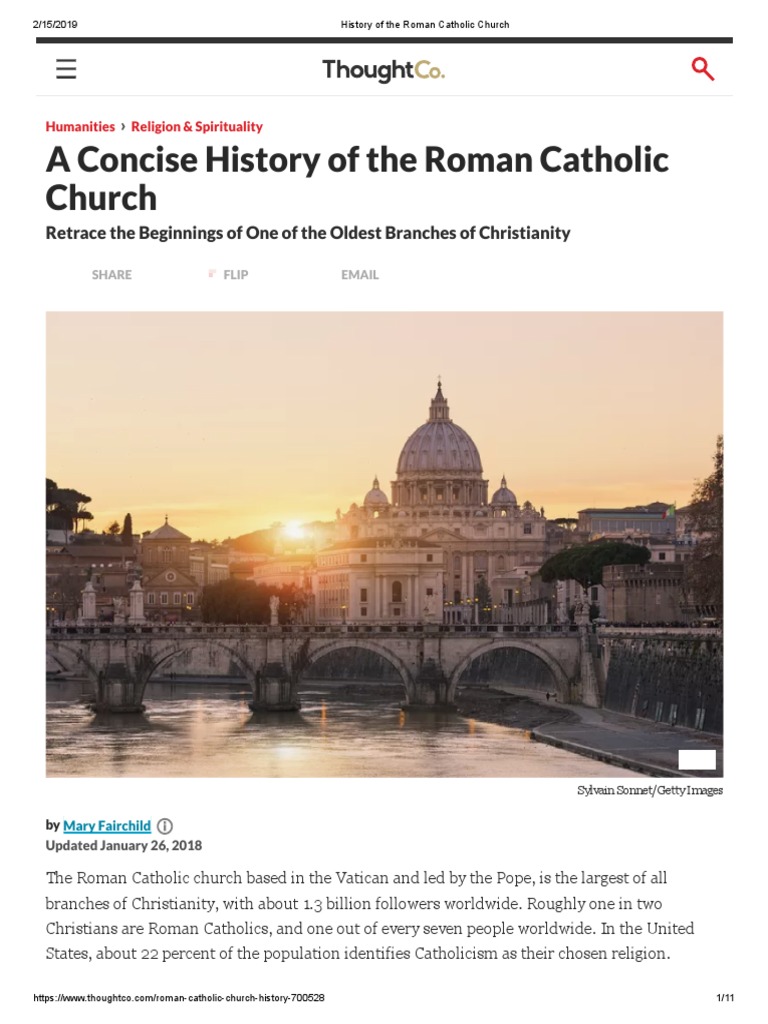In the annals of history, few phenomena have exerted as profound an influence on civilization as the inception and evolution of Roman Catholicism. The journey began in the 1st century AD, intertwined with the life and teachings of Jesus Christ and his apostles, ultimately culminating in an ecclesiastical institution that would endure for nearly two millennia. To understand how Roman Catholicism started, one must delve into the formative years of the early Church, scrutinizing the conditions, beliefs, and socio-political landscapes that shaped its emergence.
The genesis of Roman Catholicism can be traced to the tumultuous environment of the Roman Empire during the time of Jesus Christ. In this period, various ideologies and beliefs clashed, offering a fertile ground for the seeds of Christianity to take root. Jesus, a figure imbued with a transformative vision of love and redemption, preached the gospel of the Kingdom of God. His crucifixion marked a pivotal moment, but it was the resurrection that galvanized his followers, immediately setting into motion the spread of his teachings.
In the immediate aftermath of Christ’s resurrection, the apostles dedicated themselves to disseminating his message. This nascent community, often referred to as the “early Church,” was characterized by its emphasis on communal living, adherence to the teachings of Jesus, and the empowerment of the Holy Spirit—a concept that would become foundational in Catholic doctrine. Despite facing severe persecution from both the Jewish authorities and the Roman state, the early Christian community flourished. The resolve of these early believers, coupled with their compelling message of hope and salvation, allowed Christianity to gain traction throughout the empire.
As the Church gradually expanded, it began to establish a structured leadership to maintain doctrinal integrity and unity among its members. The role of bishops emerged as crucial, serving not only as spiritual leaders but also as protectors of the faith. The Bishop of Rome, recognized as a principal authority figure, laid the groundwork for what would eventually become the papacy. This development was not merely a matter of ecclesiastical governance; it was a response to the spiraling complexity of managing diverse Christian communities, each grappling with varying interpretations of Jesus’ teachings.
By the time of Emperor Constantine in the early 4th century, the dynamics of the Church had shifted significantly. The Edict of Milan in 313 AD granted Christians the right to worship openly, heralding a new era of acceptance. Constantine’s conversion was a watershed moment in the Church’s history. He assembled the First Council of Nicaea in 325 AD, where key theological disputes, particularly regarding the nature of Christ, were deliberated. The Nicene Creed, resulting from this council, illustrated an early attempt to establish uniformity in Christian belief, a concept that would be pivotal to the integrity of Roman Catholicism.
The consolidation of power and doctrine in the following centuries demonstrated Roman Catholicism’s transformative impact on society. As the Western Roman Empire crumbled in the 5th century, the Church assumed an increasingly influential role in governance and cultural preservation. Monasticism emerged as a vital force, with monks playing a significant role in safeguarding literature, philosophy, and spirituality through turbulent times. Institutions such as monasteries became centers of learning, contributing to the intellectual revival of the medieval era.
Throughout the Middle Ages, Roman Catholicism further entrenched itself not just as a spiritual authority but also as a political power. The papacy wielded significant influence, often entering into alliances and engaging in temporal politics. The Church also spearheaded the Crusades, aiming to reclaim the Holy Land and bolster Christian dominion. This era marked a complex relationship between religion and politics, as faith played a pivotal role in legitimizing authority and guiding societal norms.
However, the late medieval period also ushered in challenges that would ultimately reshape the Church’s trajectory. The rise of scholasticism during this time paired faith with reason, leading to profound theological discourse. Concurrently, disillusionment with papal excesses and profound calls for reform emerged, culminating in the Protestant Reformation in the 16th century. Figures such as Martin Luther and John Calvin challenged the Church’s practices, resulting in a fractious schism that fragmented Western Christianity.
The Catholic Counter-Reformation was the Church’s concerted response to these challenges. The Council of Trent (1545-1563) redefined Catholic doctrine, reaffirming pivotal aspects of the faith while addressing allegations of corruption. This movement revitalized the Church’s spiritual mission, sparking a resurgence in Catholicism’s reach and influence across Europe and the New World.
Fast forward to the modern era, Roman Catholicism continues to navigate an evolving global landscape. Vatican II (1962-1965) was a significant ecumenical council that embraced a reformed approach to the Church’s interaction with the contemporary world. The emphasis on dialogue, inclusivity, and social justice reflected a renewed commitment to the core tenets of Christianity amidst modern challenges.
Today, Roman Catholicism is not monolithic; it embodies a diverse array of cultural expressions and theological perspectives. The Church faces contemporary dilemmas—from issues of sexual morality to social justice initiatives—while remaining steadfast in its commitment to its foundational teachings. The legacy of Roman Catholicism is a testament to its resilient nature, one that has adapted through centuries of change while staying true to its roots.
In reflecting on its expansive history, one is compelled to appreciate not just the theological foundations but the socio-political dynamics that have shaped Roman Catholicism. Its journey from a persecuted sect to a global institution poses significant inquiries about faith, authority, and community. The evolution of Roman Catholicism invites a reconsideration of its impact on human history, prompting curiosity about how it will continue to adapt and thrive in an ever-changing world.



